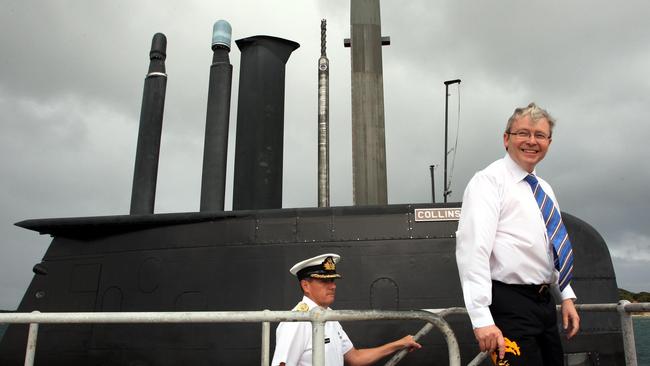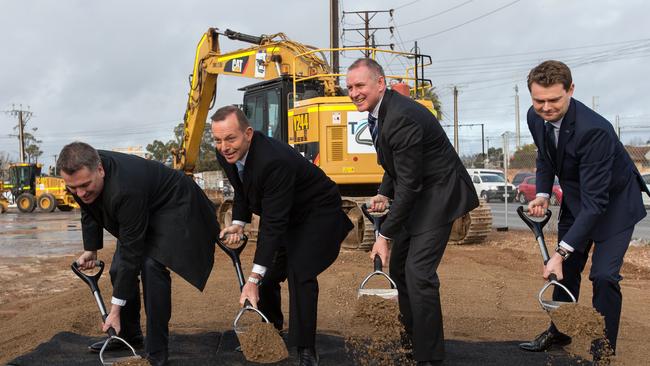Paul Starick: The high cost of living in a shrinking state like South Australia
Don’t expect much for SA in Tuesday’s federal budget – that’s what we get for living in an electoral backwater, writes Paul Starick. So what does history teach us?
Opinion
Don't miss out on the headlines from Opinion. Followed categories will be added to My News.
ANALYSIS: Once upon a time, South Australia was a battleground election state that attracted significant funding largesse.
In the earlier part of this century, John Howard’s government shovelled billions into propping up the now-defunct Adelaide car manufacturing industry and rescuing the drought-stricken River Murray.
Three months before deposing Mr Howard as prime minister in 2007, Kevin Rudd vowed a Labor government would build Australia’s next generation of hi-tech submarines in Adelaide, cutting through years of tender evaluation processes and pumping billions of dollars into the state economy.

Both leaders were desperate to win the five marginal seats within metropolitan Adelaide. In recent times, though, the federal election action has been almost everywhere bar SA.
Queensland, Western Australia and Tasmania, in particular, have produced decisive results. At the May election, so-called teal independents in Sydney and Melbourne ousted key Liberals, including prime ministerial aspirant Josh Frydenberg.
Politicians want to win government and focus on the places that can deliver power. These attract the most campaign visits and election promises – usually backed by funding pledges.
This was evident on Sunday, when Prime Minister Anthony Albanese and Infrastructure Minister Catherine King trumpeted a $9.6bn infrastructure boost to be delivered in Tuesday’s federal budget.
This was, they highlighted in a joint statement, delivering “election commitments for vital infrastructure projects across Australia”.
“Sound and planned infrastructure investment in Australia creates jobs, builds opportunity and unlocks economic growth and productivity for our cities and regions,” Mr Albanese said.
Unfortunately, there wasn’t much in the kitty for SA.
The measures they highlighted included: $2.2bn for Victoria’s Suburban Rail Link; $586.4m of extra money for Queensland’s Bruce Highway, to widen a 13km stretch through Brisbane’s outer north; $540m for Tasmania’s “important road corridors”; $125m to help build a Perth electric bus network; $300m for a Western Sydney Roads Package and $1.5bn for upgrading important freight highways. Only the final measure included SA spending, notably upgrades to the Dukes, Stuart and Augusta highways.
The total earmarked for SA in the federal budget, the Sunday Mail revealed, will be $660m. The major slice will be $200m for the removal of the Marion Rd level crossing and to upgrade Marion Rd between Cross Rd and Anzac Highway. This was a Labor promise at the May election, designed to secure the state’s only marginal seat of Boothby.

So, state Treasurer Stephen Mullighan won’t be hanging by the phone on Tuesday waiting for his federal Labor counterpart Jim Chalmers to shovel bucketloads of cash his way. The state’s big-ticket items – the new $3bn-plus Women’s and Children’s Hospital and $10bn-plus Torrens to Darlington South Rd upgrade – are outside his budget’s four-year forward estimates.
Rather, Mr Mullighan will be watching growth forecasts, GST revenue and long-term spending and economic growth predictions. The economy is strong for now, but there are growing predictions of a global downturn ensnaring Australia.
Rising inflation and interest rates are hammering householders. Floodwaters are heading into SA – everyone hopes they do not wreak havoc like they have interstate.
If inflation dissipates, Mr Mullighan likely will have some major project cost relief but, in any economic downturn, governments will have to stimulate the economy.
Other spending pressures don’t go away. For example, the state public sector grew by 3.02 per cent from 2021 to 2022 – the total headcount is 113,050, according to a report tabled in parliament on Thursday.
But SA has lagged the nation on economic and population growth. This is a substantial reason for the decline in federal seat numbers and subsequent clout in Canberra. It is important to note, though, that SA now has four federal Cabinet ministers – including Senate Leader Penny Wong and Deputy Senate Leader Don Farrell.
But as The Advertiser’s Building a Bigger, Better SA campaign has highlighted, there has been a $29bn gap between SA’s economic output and the national average in the past three decades. Population growth is vital to arrest this decline. Yet Committee for Adelaide chief Bruce Djite was howled down in some quarters for daring to suggest that Adelaide’s population should grow to two million by 2030.
There is a cost to living in a state in relative decline, whereas growth promotes opportunity and prosperity.





